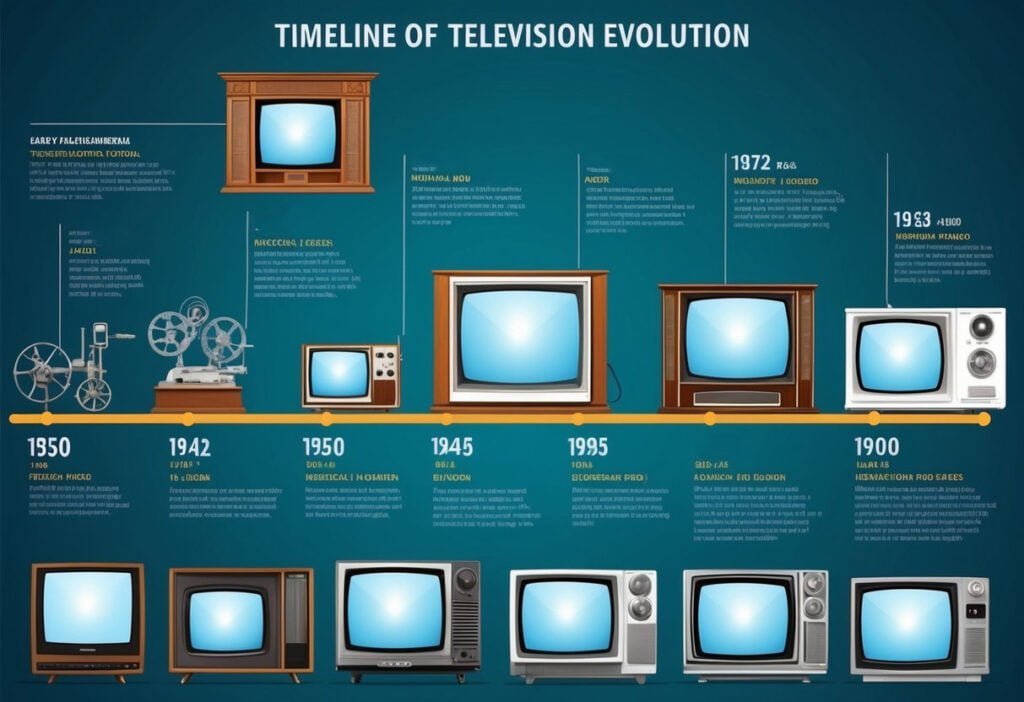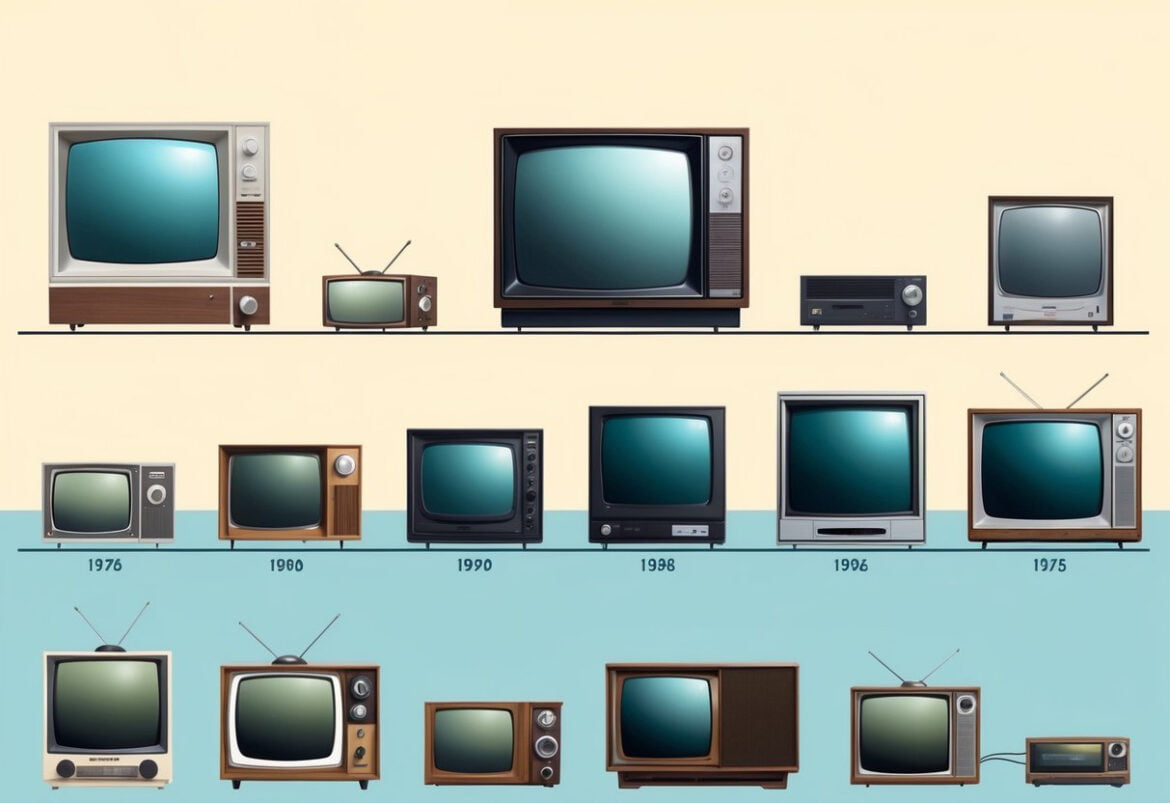Table of Contents
Television has come a long way since its inception. From early mechanical systems to today’s high-definition smart TVs, the journey has been filled with innovation and technological leaps. The evolution of television spans nearly two centuries, starting with the discovery of electromagnetism in the 1830s and progressing through various inventions and improvements.

The first practical TV systems emerged in the 1920s, using mechanical scanning disks to create images. These gave way to electronic systems in the 1930s, paving the way for widespread adoption. Color TV became commercially available in the 1950s, adding a new dimension to home entertainment.
Recent decades have seen rapid advancements in TV technology. The shift from analog to digital broadcasting, the introduction of flat-screen displays, and the rise of internet-connected smart TVs have transformed how we consume media. Today’s televisions offer stunning picture quality, immersive sound, and access to a world of online content.
Key Takeaways
- Television technology evolved from mechanical systems to electronic displays over nearly 200 years
- The shift to color, digital broadcasting, and flat screens marked major milestones in TV history
- Modern smart TVs integrate internet connectivity and offer access to diverse streaming content
Foundations of Television Technology

Television technology emerged from two key innovations: mechanical scanning systems and electronic image transmission. These breakthroughs set the stage for modern TV.
Mechanical Television Era
In the late 19th century, inventors developed mechanical scanning systems to transmit images. Paul Nipkow created a spinning disk with holes in 1884. This disk scanned images line by line.
John Logie Baird used this concept to build the first working TV system in 1925. He showed moving images on a screen. Baird’s system had 30 lines of resolution and could display 5 frames per second.
Mechanical TVs improved over time. By 1928, they could show 48 lines at 15 frames per second. But picture quality remained poor. The technology had limits.
Electronic Television Breakthrough
Electronic television solved many problems of mechanical systems. In 1897, Karl Ferdinand Braun invented the cathode-ray tube (CRT). This became a key part of TVs for decades.
Philo Farnsworth made a big leap in 1927. He created the first fully electronic TV system. It could capture, transmit, and display moving images electronically.
Farnsworth’s system offered better picture quality and faster scanning. It laid the groundwork for modern television. By 1936, the BBC began the world’s first public TV service using electronic technology.
These advances paved the way for television to become a popular medium. Electronic systems allowed for clearer pictures and easier broadcasting.
Commercialization and Growth

Television’s move from experimental technology to commercial product sparked rapid growth in the industry. New models hit the market as broadcast networks expanded their reach.
Early Television Models
The first commercial television sets became available in the late 1920s. These early models had small screens and low resolution. RCA introduced the TRK-12 in 1939, one of the first mass-produced TVs. It had a 12-inch screen and cost $600 (over $12,000 today).
TV sales grew slowly at first. By 1947, only 170,000 sets were in use in the U.S. The average TV in 1949 had a 10-inch screen and cost $269. Larger 16-inch and 19-inch models arrived in the early 1950s.
Rise of Broadcast Television
Regular television broadcasts began in the 1940s. NBC and CBS started airing programs in New York City in 1941. By 1947, there were 13 TV stations on air in the U.S.
The number of stations grew quickly:
- 1949: 69 stations
- 1952: 108 stations
- 1954: 354 stations
Popular early shows included Howdy Doody, I Love Lucy, and The Ed Sullivan Show. Networks expanded nationwide through affiliate stations. By 1955, over half of U.S. homes had a TV set.
Technological Innovations

Television technology progressed rapidly, bringing color and portability to viewers. Cable systems expanded programming options and reach.
Introduction of Color Television
Color television was a major breakthrough in the 1950s. RCA introduced the first color TV system in 1954. It used three electron beams to create red, green, and blue images.
Early color TVs were expensive and had small screens. Picture quality was often poor. But by the 1960s, improvements made color TV more affordable and popular.
Networks began broadcasting more shows in color. This drove consumer demand for color sets. By 1972, over half of US homes had a color television.
Portable and Cable TV Developments
Portable TVs emerged in the 1960s. They used transistors instead of vacuum tubes. This made them smaller and more energy-efficient. People could now watch TV anywhere.
Cable television expanded viewing options. It started in the late 1940s to improve reception in rural areas. By the 1970s, cable offered more channels and better picture quality.
Cable systems used coaxial cables to transmit signals. This allowed for many more channels than broadcast TV. It also eliminated reception problems caused by distance or terrain.
Era of Standardization and Regulation
Television signals needed consistent standards to work across different devices. Two major committees shaped these standards in the United States, setting guidelines for analog and digital broadcasts.
National Television System Committee (NTSC)
The NTSC formed in 1940 to create uniform television standards. In 1941, it set rules for black-and-white TV broadcasts. The committee met again in 1950 to tackle color TV standards.
In 1953, the NTSC established the color TV system used in North America and parts of Asia. This system allowed color broadcasts while remaining compatible with existing black-and-white TVs.
The NTSC standard defined:
- 525 scan lines
- 30 frames per second
- 4:3 aspect ratio
Advanced Television Systems Committee (ATSC)
The ATSC formed in 1982 to develop standards for digital television. It replaced the older NTSC system in the United States.
Key ATSC developments:
- High-definition TV (HDTV) standards
- Digital audio compression
- Enhanced closed captioning
The ATSC standard became official in 1996. It allowed for better picture quality, multiple sub-channels, and interactive features.
In 2009, the U.S. switched from analog NTSC to digital ATSC broadcasts. This change improved signal quality and freed up airwaves for other uses.
The Digital Revolution
Television technology underwent major changes in the late 20th and early 21st centuries. Digital formats replaced analog signals, bringing clearer pictures and new features to viewers.
Transition to Digital Television
The shift from analog to digital TV began in the 1990s. Digital signals allowed for better picture quality and more channels. Many countries set dates to end analog broadcasts. The U.S. made the switch in 2009.
Digital television brought sharper images and surround sound. It also enabled interactive features and on-screen program guides. Older analog TV sets needed converter boxes to receive digital signals.
Cable and satellite providers moved to digital too. This freed up bandwidth for more channels and services. The change impacted how people watched TV at home.
The Advent of High-Definition and 3D Television
High-definition television (HDTV) offered much clearer pictures than standard TV. It had more pixels and a wider screen format. HDTV became popular in the 2000s as prices for HD sets dropped.
3D TV tried to bring depth to home viewing. It used special glasses to create a 3D effect. The technology peaked in the early 2010s but didn’t catch on widely.
4K and 8K TVs pushed resolution even higher. These ultra HD sets showed incredibly detailed images. Smart TVs added internet features, letting viewers stream shows and use apps.
Global Expansion and Diversification
Television grew beyond national borders and became a global phenomenon. Networks spread worldwide, and new technologies changed how people watched TV.
Growth of Television Networks
Television networks expanded rapidly in the mid-20th century. CBS, NBC, and ABC dominated in the United States. The BBC led in the UK.
These networks created popular shows that aired in many countries. “I Love Lucy” and “Doctor Who” gained fans worldwide.
In 1962, the first transatlantic television signal was sent via satellite. This paved the way for global TV broadcasts.
Cable TV emerged in the 1970s, offering more channels and choices. It changed how people watched television.
Impact of Global Television Service
Global TV services brought the world into people’s homes. News traveled faster than ever before.
The 1969 moon landing was watched by millions around the globe. It showed TV’s power to unite people across borders.
Satellite broadcasting in the 1980s and 1990s further expanded TV’s reach. It allowed for live coverage of world events.
MTV launched in 1981, spreading American pop culture worldwide. It influenced music and fashion globally.
The Internet changed TV again in the 2000s. Streaming services like Netflix offered new ways to watch shows and movies.
Modern Television and Future Trends
Television has transformed dramatically in recent years. New technologies and internet integration have changed how we watch and interact with TV content.
Convergence of Television and Internet
Internet technology and satellite broadcasting have reshaped television. Smart TVs now connect directly to the internet, giving viewers access to streaming services and on-demand content.
Many people now watch television through apps on various devices. This shift has led to a decline in traditional cable TV subscriptions.
Streaming platforms like Netflix, Hulu, and Amazon Prime Video have become major players in the TV industry. They produce their own shows and movies, competing with traditional networks.
Social media integration allows viewers to interact with TV content in real-time. People can discuss shows, vote on outcomes, and engage with creators directly.
Emerging Technologies in Television
New technology continues to enhance the TV viewing experience. 4K and 8K displays offer incredibly sharp picture quality, while HDR provides more vibrant colors and contrast.
OLED and QLED screens improve image quality further. These technologies produce deeper blacks and brighter colors than traditional LED TVs.
Voice control and AI assistants are becoming common in modern TV sets. Viewers can change channels, search for content, and control smart home devices using voice commands.
Augmented reality (AR) and virtual reality (VR) are starting to merge with TV. Some shows now offer interactive AR elements or immersive VR experiences.
3D TV technology, while not widely adopted, continues to evolve. Some manufacturers are developing glasses-free 3D displays for a more natural viewing experience.

